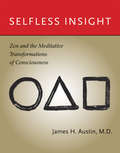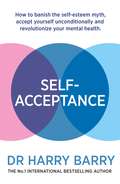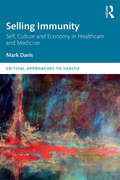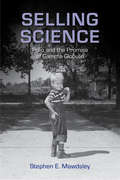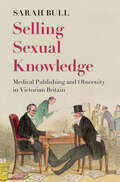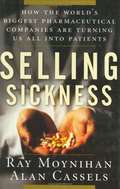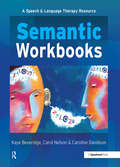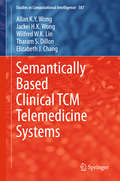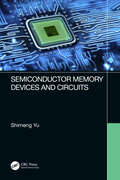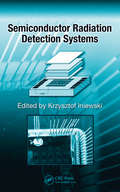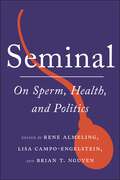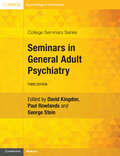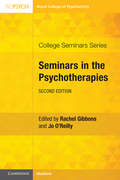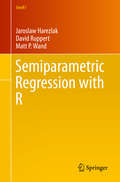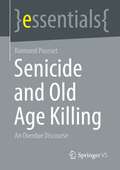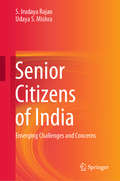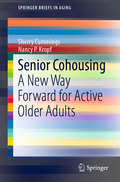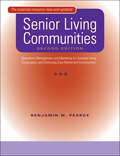- Table View
- List View
Selfless Insight: Zen and the Meditative Transformations of Consciousness
by James H. AustinAttention, self-consciousness, insight, wisdom, emotional maturity: how Zen teachings can illuminate the way our brains function and vice-versa. When neurology researcher James Austin began Zen training, he found that his medical education was inadequate. During the past three decades, he has been at the cutting edge of both Zen and neuroscience, constantly discovering new examples of how these two large fields each illuminate the other. Now, in Selfless Insight, Austin arrives at a fresh synthesis, one that invokes the latest brain research to explain the basis for meditative states and clarifies what Zen awakening implies for our understanding of consciousness. Austin, author of the widely read Zen and the Brain, reminds us why Zen meditation is not only mindfully attentive but evolves to become increasingly selfless and intuitive. Meditators are gradually learning how to replace over-emotionality with calm, clear objective comprehension. In this new book, Austin discusses how meditation trains our attention, reprogramming it toward subtle forms of awareness that are more openly mindful. He explains how our maladaptive notions of self are rooted in interactive brain functions. And he describes how, after the extraordinary, deep states of kensho-satori strike off the roots of the self, a flash of transforming insight-wisdom leads toward ways of living more harmoniously and selflessly. Selfless Insight is the capstone to Austin's journey both as a creative neuroscientist and as a Zen practitioner. His quest has spanned an era of unprecedented progress in brain research and has helped define the exciting new field of contemplative neuroscience.
Self–Acceptance: How to banish the self-esteem myth, accept yourself unconditionally and revolutionise your mental health
by Dr Harry BarryHow to look after your mental wellbeing in times of stressIn an age where self-esteem is seen as essential to mental health, we are seeing unprecedented rises in mental health difficulties from depression anxiety, eating disorders and many others. Is there not a dichotomy at play here? Is Self - Esteem (ie 'I live for my rating') a reality at all or simply a myth we are all buying into. In this book bestselling author Harry Barry challenges the conventional wisdom and explores why the terms self-acceptance, self-respect and self-actualization are more helpful in developing positive mental health. In his trademark style he also provides practical examples of what we should all be doing instead to build confidence and reach our full potential.Part 1: The myth of self-esteemPart 2: Debunking the myth of 'low self-esteem'Part 3: Debunking the myth of 'high self-esteem'Part 4: Debunking the myth 'others can dictate my self-esteem'
Selling Immunity Self, Culture and Economy in Healthcare and Medicine (Critical Approaches to Health)
by Mark DavisSelling Immunity: Self, Culture and Economy in Healthcare and Medicine provides a groundbreaking study of the ways in which immunity shapes life. Through its up-to-date discussion of immunity cultures, alongside detailed real-world examples, the book demonstrates how immunity is enmeshed in concepts of possessive individualism, self-defence and health consumerism. The book explores the rich metaphorical powers of immunity and the life narratives it inspires with reference to the talk of scientists, immunology texts and popular science magazines. The author provides a detailed overview of the ways in which digital media can shape the immune self with reference to cultural and social theories, providing insight into how immunitary knowledge and products are consumed and the benefits and drawbacks this has for healthcare. The book considers the significance of immunity for individuals navigating the threats to health that arise with pandemics and superbugs, with a keen look into how these ideas surface in everyday life across the globe. Finally, the book also discusses economic bases of healthcare technologies bent towards the protection and restoration of immunity. This book is essential reading for professionals within the fields of psychology, sociology, biomedical science, healthcare and other related disciplines. A broader audience will appreciate the book’s attention on the ways immunity is understood to be a personal possession, an object of life craft, and the basis for healthcare consumerism.
Selling Our Souls: The Commodification of Hospital Care in the United States
by Adam Dalton ReichHealth care costs make up nearly a fifth of U.S. gross domestic product, but health care is a peculiar thing to buy and sell. Both a scarce resource and a basic need, it involves physical and emotional vulnerability and at the same time it operates as big business. Patients have little choice but to trust those who provide them care, but even those providers confront a great deal of medical uncertainty about the services they offer. Selling Our Souls looks at the contradictions inherent in one particular health care market—hospital care. Based on extensive interviews and observations across the three hospitals of one California city, the book explores the tensions embedded in the market for hospital care, how different hospitals manage these tensions, the historical trajectories driving disparities in contemporary hospital practice, and the perils and possibilities of various models of care.As Adam Reich shows, the book's three featured hospitals could not be more different in background or contemporary practice. PubliCare was founded in the late nineteenth century as an almshouse in order to address the needs of the destitute. HolyCare was founded by an order of nuns in the mid-twentieth century, offering spiritual comfort to the paying patient. And GroupCare was founded in the late twentieth century to rationalize and economize care for middle-class patients and their employers. Reich explains how these legacies play out today in terms of the hospitals' different responses to similar market pressures, and the varieties of care that result.Selling Our Souls is an in-depth investigation into how hospital organizations and the people who work in them make sense of and respond to the modern health care market.
Selling Science: Polio and the Promise of Gamma Globulin
by Stephen E. MawdsleyToday, when many parents seem reluctant to have their children vaccinated, even with long proven medications, the Salk vaccine trial, which enrolled millions of healthy children to test an unproven medical intervention, seems nothing short of astonishing. In Selling Science, medical historian Stephen E. Mawdsley recounts the untold story of the first large clinical trial to control polio using healthy children--55,000 healthy children--revealing how this long-forgotten incident cleared the path for Salk's later trial. Mawdsley describes how, in the early 1950s, Dr. William Hammon and the National Foundation for Infantile Paralysis launched a pioneering medical experiment on a previously untried scale. Conducted on over 55,000 healthy children in Texas, Utah, Iowa, and Nebraska, this landmark study assessed the safety and effectiveness of a blood component, gamma globulin, to prevent paralytic polio. The value of the proposed experiment was questioned by many prominent health professionals as it harbored potential health risks, but as Mawdsley points out, compromise and coercion moved it forward. And though the trial returned dubious results, it was presented to the public as a triumph and used to justify a federally sanctioned mass immunization study on thousands of families between 1953 and 1954. Indeed, the concept, conduct, and outcome of the GG study were sold to health professionals, medical researchers, and the public at each stage. At a time when most Americans trusted scientists, their mutual encounter under the auspices of conquering disease was shaped by politics, marketing, and at times, deception. Drawing on oral history interviews, medical journals, newspapers, meeting minutes, and private institutional records, Selling Science sheds light on the ethics of scientific conduct, and on the power of marketing to shape public opinion about medical experimentation.
Selling Sexual Knowledge: Medical Publishing and Obscenity in Victorian Britain
by Sarah BullBringing together perspectives from the histories of medicine, sexuality, and the book, Sarah Bull presents the first study of how medical publications on sexual matters were made, promoted, and sold in Victorian Britain. Drawing on pamphlets, manuals, textbooks, periodicals, and more, this innovative book illustrates the free and unruly circulation of sexual information through a rapidly expanding publishing industry. Bull demonstrates how the ease with which print could be copied and claimed, recast and repurposed, presented persistent challenges to those seeking to position themselves as authorities over sexual knowledge at this pivotal moment. Medical publishers, practitioners, and activists embraced allegations of obscenity and censorship to promote ideas, contest authority, and consolidate emergent collective identities. Layer by layer, their actions helped create and sustain one of the most potent myths ever made about the Victorians: their sexual ignorance.This title is also available as open access on Cambridge Core.
Selling Sickness: How the World's Biggest Pharmaceutical Companies Are Turning Us All Into Patients
by Ray Moynihan Alan CasselsThis book presents a valuable counterweight to the mind-numbing barrage of unproven diagnoses and just plain dysinformation that haunts the airwaves and even some medical journals.
Selling Teaching Hospitals and Practice Plans: George Washington and Georgetown Universities
by John A. KastorWhy would a university renowned for its school of medicine ever sell its teaching hospital? In his newest book, Dr. John A. Kastor presents an insider’s view of why university medical centers decide to sell teaching hospitals, why the decision might be a good one, and how such transitions are received by the faculty and administration.Kastor tells the story of two universities that, under financial duress for more than a decade, chose to sell their teaching hospitals. George Washington University sold to a national, for-profit corporation, Universal Health Services, Inc., and Georgetown University sold to a not-for-profit, local company, MedStar Health. Through interviews with key players involved in and affected by these decisions, Kastor examines the advantages and disadvantages of selling and describes the problems that can afflict medical schools that separate from their faculty practice plans. For the current leaders of medical schools facing similar financial challenges, Kastor analyzes how much it costs to teach clinical medicine and offers valuable advice on how to reduce expenses and increase surpluses.
Seltene Erkrankungen und der lange Weg zur Diagnose: 15 persönliche Fallgeschichten
by Lorenz GrigullDas Buch zeichnet in 15 Fallvignetten den ganz individuellen Weg von Patienten mit seltenen Erkrankungen nach - Kinder und Erwachsene. Spannend und anschaulich schildert der Autor ihren Lebens- und Leidensweg auf der Suche nach einer Diagnose. Kinder- und Jugendärzte, aber auch alle anderen Haus- und Fachärzte lernen anhand dieser individuellen Fälle, genau hinzusehen, dem Patienten die richtigen Fragen zu stellen und auf Schlüsselerlebnisse zu achten. Den persönlichen Schilderungen folgen eine kurze Darstellung der Klink mit diagnostischen Hinweisen, Therapieoptionen sowie Links und Servicetipps für Arzt und Patient. Ziel des Buches ist, das Bewusstsein dafür zu schärfen, wann eine seltene Erkrankung in Betracht gezogen werden muss.
Seltene Lungenerkrankungen
by Felix Jf Herth Michael Kreuter Ulrich Costabel Detlef KirstenDieses Buch schließt eine Lücke und erspart mühsame Recherchearbeit. Das interdisziplinäre Herausgeber- und Autorenteam bestehend aus Pneumologen, Rheumatologen Radiologen, und Pathologen stellt seltene Erkrankungen der Lunge übersichtlich und systematisch nach den folgenden Kriterien dar: Ätiologie, Epidemiologie, Klinik, Diagnostik, Pathologie, Radiologie, Therapie und Prognose. Ob idiopathische interstitielle Pneumonien, Sarkoidose, Lungenbeteiligungen bei Kollagenosen, Lymphangiolyomyomatose, Alveolarproteinose, eosinophile Pneumonien, Lungenemphysem bei Alpha-1 Antitrypsinmangels, Bronchiolitiden , Mucoviszidose oder anderen seltenen Erkrankungen, der Leser erhält praxisnahe Antworten auf seine Fragen von bekannten Experten ihres Fachgebietes. Die 2. Auflage wurde komplett aktualisiert und um folgende Themen erweitert: Seltene berufsbezogene Lungenerkrankungen, seltene Infekte und Zwerchfellparese.
Semantic Workbooks
by Carol Nelson Kay Beveridge Caroline Davidson Stobhill HospitalUsing hundreds of clear and captivating illustrations, this resource, divided into 6 sections, housed in a ring binder provides a range of semantic therapy ideas and materials. Designed for use with adults with acquired neurological disorders and based on the cognitive neuropsychological model of language processing, each workbook covers specific aspects of semantics. "Contains an excellent range of visual materials. "Gives a range of semantic therapy ideas and materials that can be used individually or modified for use with groups. "Exercises are graded in order of difficulty and presented in a range of formats, eg, pictures only, written word only and pictures with words. "Designed for use with adults with acquired neurological disorders and based on the cognitive neuropsychological model of language processing. "Many of the picture exercises would also be suitable for semantic work with children. "Gives the busy therapist an easy, quick and high quality resource for everyday use. Carol Nelson and Caroline Davidson have worked at the Stobhill Hospital in Glasgow for several years. These workbooks were created as an easily usable resource for therapists who work with aphasic clients. After 13 years' experience in working with children and young adults with learning disabilities Kave Beveridge moved to the position of Speech and Language Therapy Assistant at Stobhill Hospital in 1993. She worked in the Speech and Language Therapy department until she retired in September 2008.
Semantically Based Clinical TCM Telemedicine Systems
by Allan K. Y. Wong Jackei H. K. Wong Wilfred W. K. Lin Tharam S. Dillon Elizabeth J. ChangRecent years have seen the development of two significant trends namely: the adoption of some Traditional Chinese Medicine Practices into mainstream Allopathic Western Medicine and the advent of the internet and broad band networks leading to an increased interest in the use of Telemedicine to deliver medical services. In this book, we see the convergence of these two trends leading to a semantically-based TCM Telemedicine system that utilizes an ontology to provide sharable knowledge in the TCM realm to achieve this. The underpinning research required the development of a three-layer architecture and an Ontology of the TCM knowledge. As TCM knowledge like all medical knowledge is not frozen in time it was important to develop an approach that would allow evolution of the Ontology when new evidence became available. In order for the system to be practically grounded it was important to work with an industry partner PuraPharm Group/HerbMiners Informatics Limited. This partnership was initiated through Professor Allan Wong and the Chairman of PuraPharm Group Mr. Abraham Chan. This led to the system being utilized in more than 20 Mobile Clinics in Hong Kong and 300 Hospitals in China. In order for these different deployments of the system to be coherent with the main core Ontology, it was necessary for us to develop an Ontology Driven Software System Generation approach.
Semiconductor Memory Devices and Circuits
by Shimeng YuThis book covers semiconductor memory technologies from device bit-cell structures to memory array design with an emphasis on recent industry scaling trends and cutting-edge technologies. The first part of the book discusses the mainstream semiconductor memory technologies. The second part of the book discusses the emerging memory candidates that may have the potential to change the memory hierarchy, and surveys new applications of memory technologies for machine/deep learning applications. This book is intended for graduate students in electrical and computer engineering programs and researchers or industry professionals in semiconductors and microelectronics. Explains the design of basic memory bit-cells including 6-transistor SRAM, 1-transistor-1-capacitor DRAM, and floating gate/charge trap FLASH transistor Examines the design of the peripheral circuits including the sense amplifier and array-level organization for the memory array Examines industry trends of memory technologies such as FinFET based SRAM, High-Bandwidth-Memory (HBM), 3D NAND Flash, and 3D X-point array Discusses the prospects and challenges of emerging memory technologies such as PCM, RRAM, STT-MRAM/SOT-MRAM and FeRAM/FeFET Explores the new applications such as in-memory computing for AI hardware acceleration.
Semiconductor Radiation Detection Systems (Devices, Circuits, and Systems)
by Krzysztof IniewskiSemiconductor Radiation Detection Systems addresses the state-of-the-art in the design of semiconductor detectors and integrated circuit design, in the context of medical imaging using ionizing radiation. It addresses exciting new opportunities in X-ray detection, Computer Tomography (CT), bone dosimetry, and nuclear medicine (PET, SPECT). In addition to medical imaging, the book explores other applications of semiconductor radiation detection systems in security applications such as luggage scanning, dirty bomb detection, and border control. Features a chapter written by well-known Gamma-Ray Imaging authority Tadayuki Takahashi Assembled by a combination of top industrial experts and academic professors, this book is more than just a product manual. It is practical enough to provide a solid explanation of presented technologies, incorporating material that offers an optimal balance of scientific and academic theory. With less of a focus on math and physical details, the author concentrates more on exploring exactly how technologies are being used. With its combined coverage of new materials and innovative new system approaches, as well as a succinct overview of recent developments, this book is an invaluable tool for any engineer, professional, or student working in electronics or an associated field.
Seminal: On Sperm, Health, and Politics (Health, Society, and Inequality)
by Rene Almeling Lisa Campo-Engelstein Brian T. NguyenThe complexities and controversies at the nexus of sperm, health, and politicsIn Seminal, experts from across the social sciences, humanities, law, and medicine offer a kaleidoscopic view of the relationship between sperm, health, and the intersecting politics of gender, race, and reproduction. Always insightful and often provocative, the essays in this unprecedented collection cover a broad range of issues related to male reproductive and sexual health—including the latest technological developments for creating sperm; the specter of eugenics in contemporary medical markets; emerging approaches to male contraceptive methods, male infertility, and trans healthcare; controversies surrounding sperm donors and sperm banking; disparities in sexual health education for teens—all the while attending to the enormous variation in how individuals and societies understand, embody, and experience sperm.At a time when the most basic rights of reproductive autonomy are under severe threat, contributors to this volume argue this is precisely the moment to rethink and reimagine sperm from a variety of medical, political, and cultural perspectives. Ultimately, this volume aims to contribute to a more reproductively just society and broaden conversations around bodies, health and equity in the United States.
Seminars in Forensic Psychiatry (College Seminars Series)
by Harry Kennedy Mary DavorenThis updated edition of Seminars in Forensic Psychiatry is an invaluable guide for consultants and specialist trainees working in forensic psychiatry. Written by leading international contributors, topics include models of care, the management of in-patient violence, forensic psychotherapy, and psychological treatments. The evolution of policy and mental health law is discussed, demonstrating how it has shaped the provision of forensic psychiatry services. Legal aspects include considerations of mentalistic defences in criminal law, mental health law, as well as the law on negligence. The book also includes sections on specialist areas of need, including cultural and gender specific needs, terrorism, stalkers, and sex offenders. Woven into the chapters are practical approaches, and 'how to' guides. The volume ends with advice for each of the transitions in the career of a forensic psychiatrist. A truly practical guide, this is a must-read for psychiatrists and mental health professionals working within a forensic setting.
Seminars in General Adult Psychiatry (College Seminars Series)
by David Kingdon Paul Rowlands George SteinThis long-awaited third edition of Seminars in General Adult Psychiatry provides a highly readable and comprehensive account of modern general adult psychiatry. The text has been fully updated throughout by leading figures in modern psychiatry. This new edition covers developments in the understanding of mental disorders, service delivery, changes to risk assessment and management, collaborate care plans and 'trauma-informed' care. Coverage will also be given to the implementation of the ICD-11 and DSM-5 classification systems, and the impact on diagnosis and treatment. Key features of the previous edition that have been updated include the detailed clinical descriptions of psychiatric disorders and historical sections with access to the classic studies of psychiatry. Additional topics include autism, ADHD and physical health. This is a key text for psychiatric trainees studying for their MRCPsych exams, and a source of continuing professional development for psychiatrists and other mental health professionals.
Seminars in the Psychotherapies (College Seminars Series)
by Rachel Gibbons Jo O’ReillyThis comprehensive and highly readable book outlines the main psychological therapies used in contemporary clinical practice. It clearly describes the underlying theoretical principles and techniques and with vivid case examples, demonstrates the central role of these treatments in mental health care. The contribution of psychological and psychodynamic ideas to different psychiatric presentations is outlined, including mood disorders, psychosis, self harm and suicide. Other chapters specifically address recent developments, including neuropsychoanalysis, psychedelic-assisted psychotherapy and Open Dialogue. As the chapters unfold this book illustrates how a psychologically informed approach to mental disorder can enrich psychiatric practice by providing a holistic and meaningful understanding of the symptoms of psychological distress. Bringing together ideas from psychiatry and psychotherapy, this is the go-to text for trainees, experienced psychiatrists, and other mental health professionals interested in the psychological and psychodynamic aspects of psychiatry. An essential resource for preparation for the MRCPsych examinations.
Semiparametric Regression with R (Use R!)
by David Ruppert Jaroslaw Harezlak Matt P. WandThis easy-to-follow applied book on semiparametric regression methods using R is intended to close the gap between the available methodology and its use in practice. Semiparametric regression has a large literature but much of it is geared towards data analysts who have advanced knowledge of statistical methods. While R now has a great deal of semiparametric regression functionality, many of these developments have not trickled down to rank-and-file statistical analysts. The authors assemble a broad range of semiparametric regression R analyses and put them in a form that is useful for applied researchers. There are chapters devoted to penalized spines, generalized additive models, grouped data, bivariate extensions of penalized spines, and spatial semi-parametric regression models. Where feasible, the R code is provided in the text, however the book is also accompanied by an external website complete with datasets and R code. Because of its flexibility, semiparametric regression has proven to be of great value with many applications in fields as diverse as astronomy, biology, medicine, economics, and finance. This book is intended for applied statistical analysts who have some familiarity with R.
Sendabide ala iruzurbide
by Simon Singh eta Edzard ErnstMedikuntza alternatiboaren azterketa berritzaile honetan, tratamendu ezagunenak aztertzen dira —besteak beste, akupuntura, homeopatia, aromaterapia, erreflexologia, kiropraktika eta sendabelarren medikuntza—, haien frogatutako onurak eta balizko arriskuak ikusteko. Baina zerk balio du eta zerk ez? Terapia alternatiboen eraginkortasunari buruz zer froga zientifiko dauden jakin nahi duen edonorentzat informazio zoragarria eta zientzia-azalpen argiak ematen ditu.Zientziak esperimentuak, behaketak, saiakuntzak, arrazoiketa eta eztabaida erabiltzen ditu egiaren inguruko adostasun objektibo batera iristeko. Ondorio bat erabakita dagoenean ere, zientziak ikertu eta zirikatu egiten du berak aldarrikatu duen hori, akatsen bat egin badu ere.Osasun publikoaren jardunbidearen eta politikaren gaineko erabakiak hartzeko metodo zientifikoak duen garrantzia berresten ahalegintzen da liburua, sendabide alternatibo eta osagarriekiko zorrotz jokatuz.
Senescence Back and Forth
by Urs Nydegger Thomas LungThis book is about lifelong ageing of humans. The basic biochemical and genetic mechanisms remain ill known, and differ among individuals. The book starts out to explore the plant and animal kingdoms to answer questions human ageing needs for understanding. First, we come to scrutinize time running out and what ‘normal’ means with impacts on the genome and on protein half- lives and function. Ageing goes beyond biochemical skid treated by geroprotector drugs, including biosimilars; albeit early diagnosis with standard medical laboratory assays, here addressed, sheds light with focus on basic research. Modern tools, including machine learning, and DNA technology, e.g. genomics, have already provided for unanticipated insights. The chapters then turn around senescence of the entire organism based on variable ageing of single organs embedded in neuronal networks . Psychological stress factors, dementia opposed to vigilance, and distinction of ageing from overt disease are contrasting in humans and are opposed in the book. Senescence, seen as a one way track may be reverted into rejuvenation, made possible by insights into immunosenescence and genomic approaches. Risk management in health insurance finds important clues in this book. The topics addressed between the book covers help to understand the trend to the ever- prolonging life expectancy beyond the centenarian age group; nursing care takers and pharmaceutical industry are invited to understand what’ is going on in senior people to make their geriatric population remain fit or become frail.
Senicide and Old Age Killing: An Overdue Discourse (essentials)
by Raimund PoussetRaimund Pousset gives in this essential a concise account of senicide, the modern form of cultural killing of the elderly. He sheds light on both the history and the current situation of an ancient method. Practiced for millennia almost everywhere in the world, this custom of actively disposing of old 'useless' people or passively putting oneself to death is increasingly being revived today. Senicide is a nameless and silent scandal in our modern, enlightened society. The author wishes to bring this silent death into the focus of a mindful professional public, for the segregation of old age and the avalanche of costs in health care suggest that senicide will continue to grow in sad significance
Senior Citizens of India: Emerging Challenges and Concerns
by Udaya S. Mishra S. Irudaya RajanThis book provides an overview of multiple facets of ageing and its evolving dynamics in various Indian states. It elaborates on key dimensions like health, dependence and disability, as well as living arrangements for the elderly. Drawing on information from National Sample Surveys to offer readers a broader and richer understanding of the evolving demographic reality in India, the book addresses a range of detailed policies and programmes for the elderly in India. Given its scope, the book is essential reading for students and researchers in the fields of sociology, demography, economics and development studies. It also offers a valuable reference guide for anyone engaged in planning and policy formulation for social security, welfare of the aged or mainstreaming ageing concerns.
Senior Cohousing: A New Way Forward for Active Older Adults (SpringerBriefs in Aging)
by Sherry Cummings Nancy P. KropfThis book presents a concise description and qualitative exploration of a new residential option for older adults: senior cohousing. It describes the practical, structural and communal aspects of senior cohousing and shares the lived experiences of actual residents. Pursuing an existential-phenomenological approach, the authors visited a selection of senior cohousing communities throughout the US and interviewed members to investigate their experiences in several regards: gathering together; developing the mission and architectural design; defining member expectations for the community; and engaging in cooperative self-management, consensus building, shared tasks and mutual activities as an ongoing way of life. In addition, the authors explored the benefits, challenges and surprises that community members have encountered along the way, and what these experiences have meant for their lives. Given its unique insights, the book offers a valuable resource for academics and all those working and interested in gerontology, sociology, psychology, nursing, public health, housing and the consumer sciences. It will also benefit active older adults who are considering new housing options.
Senior Living Communities: Operations Management and Marketing for Assisted Living, Congregate, and Continuing Care Retirement Communities
by Benjamin W. PearceThe demand for residential communities for seniors rises as the U.S. population continues to age. This growth means that new administrators and staff members often are learning by trial and error the complicated task of delivering high-quality and consistent services to elderly persons. While many new facilities have been successful, others have been plagued by a variety of administrative and financial difficulties. Senior Living Communities remains the definitive guide to managing these facilities.In this thoroughly updated and revised edition, Benjamin W. Pearce offers a wealth of sound advice and practical solutions. He discusses resident relations, operating methods, staffing ratios, department management, cost containment, sales and marketing strategies, techniques of financial analysis, budgeting, and human resources. New chapters address issues particular to dementia care and architecture, and the appendix contains a department-by-department audit of senior living operations.From the front lines to the boardroom, this book should be a part of every decision-making process for improving and maintaining assisted living, congregate, and continuing care retirement communities.
